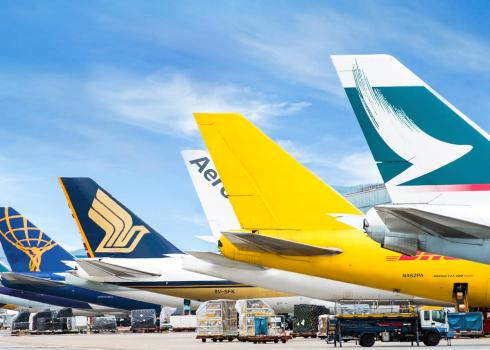
-
Hong Kong regains rank as top air cargo hub
-
Hongkong International Airport increased its cargo throughput 12.5% to 5 million metric tons in 2021
-
Strong demand for anti-COVID drugs and ecommerce buoyed air cargo market
-
Airport’s March throughput drops 11.4% due to Omicron outbreak reducing flights
Hong Kong International Airport regained its rank as the world’s busiest cargo airport in 2021 with a cargo throughput of 5 million metric tons, but a serious outbreak of the Omicron variant of COVID-19 that began in late December impacted its performance in March.
Air cargo rebound was less impacted by the pandemic, but its volumes increased globally by 15% year-on-year to an estimated record 124 million metric tons in 2021.
HKIA increased its volume by 12.5%, besting Memphis International Airport’s cargo volume, which fell 2.9% y-o-y to 4.5 million metric tons, sending it back to second position. Shanghai Pudong International Airport increased its volume by 8.0% to 4.0 million metric tons for third place.
The Airport Authority of Hong Kong, which operates the airport, attributed the growth to the global impact of COVID-19 to airline companies.
“We are delighted that HKIA maintained its leading position as the World’s Busiest Cargo Airport in 2021. The pandemic has had a serious impact on flight operations globally, but it has also generated high demand for e-commerce and transportation of medical supplies,” said Cissy Chan, AAHK executive director – commercial.
“With the airport’s extensive freighter network, high efficiency and dedicated cargo operators, we saw double-digit growth in cargo throughput during 2021. AAHK is confident in the long-term development of HKIA’s air cargo business, and will continue to work closely with our business partners to enhance our performance.”
Air cargo volumes at the top 10 airports, collectively representing about 25% (34.2 million metric tons) of the global volumes in 2021, gained 12.4% in 2021 y-o-y. ACI World attributes the gain to the continued spike in demand for online consumer goods and pharmaceuticals.
In March this year, cargo throughput at HKIA was 352,000 tons, down 11.4% y-o-y, and flight movements were 9,870, a drop of 7.3% y-o-y, the Airport Authority said on April 14.
Air cargo volumes began to fall when cargo flights were reduced due to Omicron community infections in Hong Kong in December last year that were traced to two newly arrived infected Cathay Pacific air crew who went about town while on home quarantine.
The total tally from the pandemic’s fifth wave stands at 1,184,447, with more than 9,000 deaths.
Exports and imports experienced double-digit declines year-on-year, compared with the same month last year. Overall cargo to and from North America and Europe experienced the most significant decreases during the month.
HKIA handled 94,000 passengers, representing a year-on-year increase of 61.3%, although passenger traffic remained significantly lower than the pre-pandemic level in 2019.
The increase in passenger throughput was mainly attributed to the growth in travel by Hong Kong residents. During the month, departure passengers to Southeast Asia and China experienced the most significant increases.
For the first three months of the year, cargo throughput dropped 9.2% to 1 million tons and flight movements eased 1.0% to 30,210. Passenger volume increased 41.7% to 251,000, respectively.
On a 12-month rolling basis, the airport handled 1.4 million passengers and 144,505 flight movements, recording growth of 70.4% and 13.1%, respectively. Cargo throughput rose 7.1% to 4.9 million tons.




